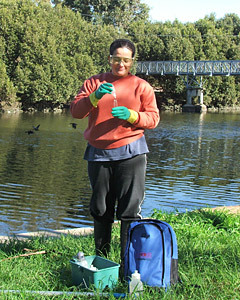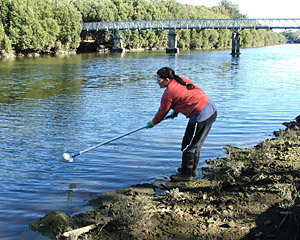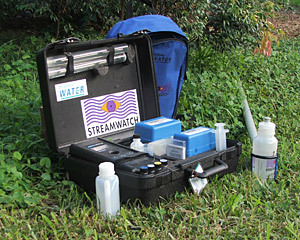Get our latest report Jun2011 Report Final
Water quality testing in the Cooks River
 One of CRVA’s key objectives is to improve the health of the Cooks River, including its water quality, the state of the riverbed and its flora and fauna. Walking along the river you might see oil slicks or floating rubbish but you cannot really tell how much oxygen or phosphate the river contains or whether it is polluted with faecal matter.
One of CRVA’s key objectives is to improve the health of the Cooks River, including its water quality, the state of the riverbed and its flora and fauna. Walking along the river you might see oil slicks or floating rubbish but you cannot really tell how much oxygen or phosphate the river contains or whether it is polluted with faecal matter.
So in November 2007, CRVA formed a small group of volunteers to make measurements of critical water quality factors.
Training and test equipment are provided through Australian Museum’s Streamwatch Program http://www.streamwatch.org.au/streamwatch/
Where do we test and what have we found?
Volunteers take water samples from the river at Ewen Park, Younger Avenue, Steel Park, Marrickville Golf Course and River Canoe Club near Tempe. You might see us on the riverbank with our bottles and pole dipping into the water to collect a sample. Then it’s back home to our portable laboratory for testing.
 We compare our results with Government guidelines [viz. Australian and New Zealand Guidelines for Fresh and Marine Water Quality ANZECC 2000]. For example, the healthy guideline range for dissolved oxygen [expressed as a percentage of the saturated value at a given temperature] is 85-110%. We often get results outside this range. Our faecal coliform values are highly variable and depend partly on weather and sewerage performance. Results frequently exceed secondary human contact levels [ie maximum for boating and fishing 1000 CFU/100ml].
We compare our results with Government guidelines [viz. Australian and New Zealand Guidelines for Fresh and Marine Water Quality ANZECC 2000]. For example, the healthy guideline range for dissolved oxygen [expressed as a percentage of the saturated value at a given temperature] is 85-110%. We often get results outside this range. Our faecal coliform values are highly variable and depend partly on weather and sewerage performance. Results frequently exceed secondary human contact levels [ie maximum for boating and fishing 1000 CFU/100ml].
What do we do with the data?
We have submitted results from over 70 testing sessions to Sydney Water for publication on the Streamwatch website. We also use the data for :
- Preparing trend analyses to identify improvements in water quality at individual sites
- Reporting to Councils
- Notifying pollution events to Councils, DECC and Sydney Water
Quality assurance
We are members of Australian Museum’s Streamwatch Program and use Streamwatch methodology and equipment. We participate in annual quality assurance events and in 2008 we won the Streamwatch Award for Outstanding Community Group.
For further information go to: http://www.streamwatch.org.au/streamwatch/ .
Are you interested?
If you are interested in joining us to learn how to test the waters or if you want to take a look at our results, contact us.
If mucking about with the river and playing with chemicals is not your thing, you can still keep an eye out for pollution by becoming a ‘CooksEye’.
Keeping a ‘Cooks Eye’ on the River – Report Pollution
If you visit the river regularly you may notice unusual things – a really bad odour or an oil slick or a large frothy scum or an unusual discharge from a drain or even a dead fish or two. We rely on regular users of the river to keep us up to date with what is happening. For example, in November 2008 we received dozens of reports from people walking and canoeing at the Cooks, of hundreds of dead fish in the river. As a result we were able to follow up with relevant agencies to identify the stormwater drain that discharged the toxic waste responsible for the fish kill. We now monitor that drain regularly.
You can keep a CooksEye on the River by reporting pollution events. We ask you to report your observations first to the relevant agency. Often this will be the local Council. And then to notify us so we can follow up to ensure action has been taken.
Download our CooksEye Info Sheet V5 on how to report a pollution event.
If you would like more information about our CooksEye program, contact us.
What’s in the Cooks River?
-
- Tidal seawater, river water, stormwater runoff, rainwater
- Fish, worms, mussels, crabs, microorganisms
- Aquatic plants and algae
- Sediments on the river bed contain heavy metals like lead, zinc and arsenic.
- And after heavy rain or sewer chokes … sewage from sewerage overflows
What does Streamwatch test and why do we test it?
| What | Why |
| Temperature | The temperature of the water has a major effect on biological activity and growth of river organisms. |
| pH | This tells us how acidic or alkaline the water is. Freshwater fish and other river life are sensitive to changes in pH. Extremely high or low pH levels will lead to the death of aquatic life. |
| Electrical conductivity | This tells us how much salt and organic acid is in the water. Freshwater organisms cannot live in very salty water. |
| Turbidity | This tells us how cloudy or muddy the water is. Turbid water reduces the amount of light entering the river environment. Plant growth decreases and this impacts on the animals that rely on the plants [for food, shelter, oxygen]. |
| Dissolved oxygen | Dissolved oxygen is essential for fish, worms, etc living in the river. Fish die if there is not enough dissolved oxygen in the water and they get environmentally ‘stressed’ if the levels are low. This means they are more susceptible to disease, etc. |
| Available phosphate | Phosphorus [in phosphates] is a nutrient essential to the growth of plants and animals. The available phosphate test tells us how much soluble phosphate there is available to plants. Too much phosphate leads to an abundance of algae and aquatic weeds. And less oxygen for fish. |
| Faecal coliforms | These are naturally occurring bacteria found in the intestines of all warm blooded animals including humans. If we find faecal coliforms in the river it generally means the river has been contaminated by human sewage. |
What results do we get?
Here are some highlights from our 2008/09 report based on 46 test sessions at 5 Cooks River sites.
- Water quality in the Cooks River is relatively poor
- On 50% or more of our tests we found:-
- low dissolved oxygen [below 85% of saturation]
- high available phosphate [above 0.0612 mg/L]
- high faecal counts [above 150 CFU/100mL primary contact level]
Results for pH and turbidity were generally within the guidelines.
Tests for faecal coliforms and E.coli were done at all sites except Richardson Crescent. We compared median results with the guidelines for primary and secondary human contact, ie for swimming and for boating. Figure 1 shows site median, maximum and minimum values. The levels are:-
- above primary contact at all sites except Younger Avenue [downstream] and in the stormwater drain itself.
- above the secondary guideline at Ewen Park.
- the highest recorded result was 20,400 CFU/100mL at Younger Ave [upstream]. This is 20 times the secondary contact guideline.
The 2010/11 Cooks River Water Quality Report is available by clicking the link below:

